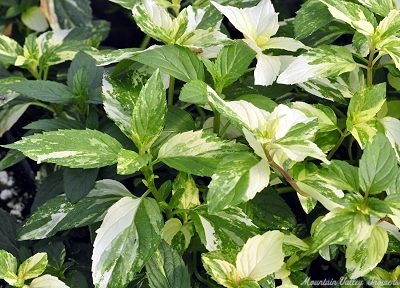Growing & using Variegated Peppermint

Variegated Peppermint is a little different and should be protected from sun that is too harsh. The white and cream sections of the leaves are very susceptible to sunburn. This normally doesn’t hurt the plant but it is disfiguring and, if left unchecked, will cause the plant to grow very slowly or die. Because we always grow Peppermint in a container it is easier to find just the right spot simply by relocating the pot.
Variegated Peppermint like most variegated plants make for intriguing garden companions. Their highlights make darker plants pop and add an interesting complement to bright flower colors. There are two kinds of variegated plants: those that are a true species and those that are variegated due to a virus or other environmental factor. Most variegated herbs fall into this second group. These virus-infected plants are referred to as sports. A sport is a stem, or, more correctly, a bud of an all-green plant that goes awry and produces a variegated branch or stem. These mutations are often selected by growers, rooted, and given a new name (Variegated Peppermint, for example). Over time this kind of variegated plant may have both all-green and variegated stems. Since there is less chlorophyll (the energy making part of the plant) in variegated leaves, a sport propagated plant may be overcome by green shoots. Removing these green shoots when they appear will keep them from overwhelming the variegated parts of the plant.
Variegated Peppermint likes to grow in well drained potting soil to which organic fertilizer has been added. Each plant needs as much room as you can provide. It is better to have a very wide container instead of a very deep one. Six inches is deep enough. There is never enough width! Most mints will need to be split up and repotted each spring to keep them healthy. See our Great Mint Repotting Caper for more on proper soil, division and replanting.
Although Variegated Peppermint is a slower growing plant than Peppermint, these two do grow similarly. These mints have two phases of growth. The first occurs in early spring as it emerges from dormancy and sends stalks upward. These stems grow tall and will become flower spikes. If you are harvesting for drying, it is best to cut these stems just as the first few buds open. The flower on the left is really too old. The problem is not the age of the flower so much as the age of the leaves. As the leaves age the essential oils change composition and the flavors are not as pepperminty. So we use the stage of the flower to gauge the appropriate time to harvest the leaves. You can actually cut the stems at anytime but usually we like to let them get as tall as possible without waiting too long. The second phase of growth occurs after flowering. At this time the plant starts sending out long runners that stay at ground level. If these runners find moist soil they root and the plant gets bigger (thus the reason for the wide pot). Read our Mint Care and Tips page for more on how to tame your mint.
Water Mint and Spearmint (Peppermint’s parents) have quite a few forms and these forms have produced other Mentha piperitas that are worth adding to your collection. These include Orange Mint, Lavender Mint, Lemon Bergamot Mint and Chocolate Mint. Peppermints in all forms have a lot of menthol in them, which can be overpowering when the leaves are used fresh. We prefer the leaves dried. This mellows the menthol and makes them more palatable. It also makes it easy to blend with other dried herbs.
Read our Mint Care and Tips page for more on how to tame your mint.
See our Great Mint Repotting Caper for more on proper soil, division and replanting of mints.

